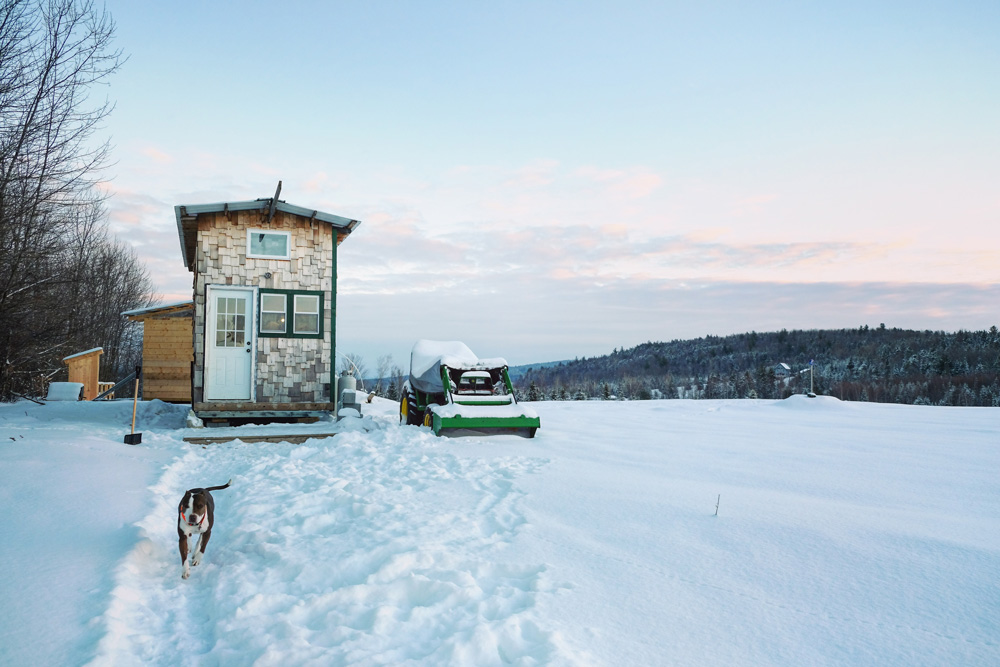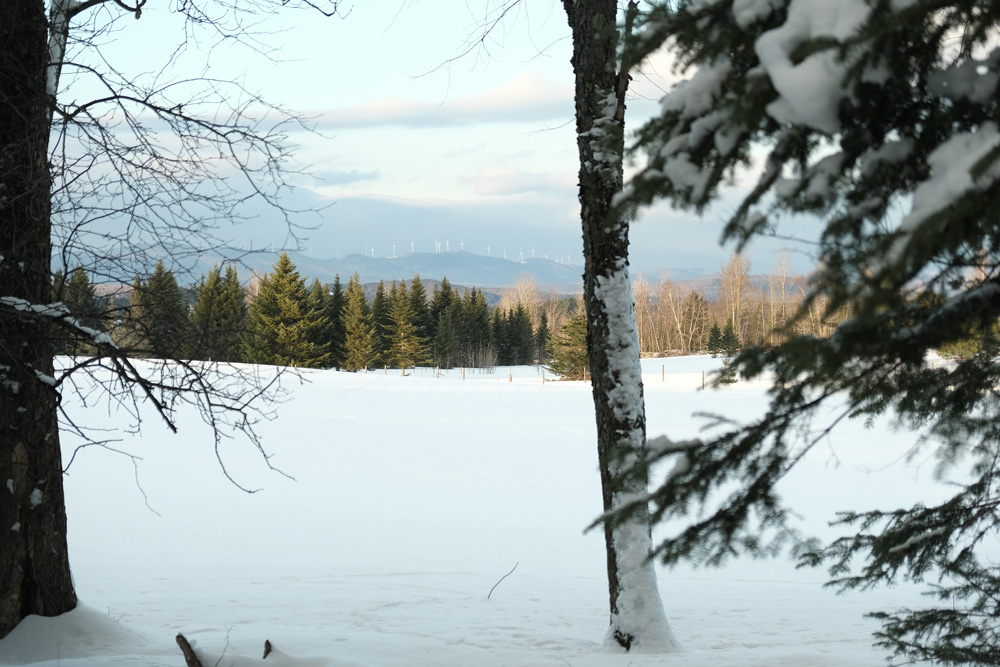Editor’s Note: This article is the first in a new series from Agrarian Trust and our contributors exploring the human side of land transition. Stay tuned for monthly posts from diverse voices, including farmers of all ages and backgrounds.
We’re pleased to present our first story from Darby Weaver, a writer and farmer with more than a decade of experience growing and moving in and out of Biodynamic farms in the Southeast and Northeast and teaching holistic and ecological methods. Her most recent project finds her in a tiny house on 20 acres in Northern Vermont where she is developing an Agroecology system with her husband, Elliot Smith.
Learn more about the Agrarian Commons Darby introduces in her article here.
by Darby Weaver

With snowshoes, I’ve been able to explore every aspect of my new property in Wolcott, Vermont. The cold temperatures and glistening snow drifts feel like a different planet from my first visit here in the early days of June. Buying this piece of land was the culmination of a ten year long dream my husband and I shared as we raised crops and livestock in the Southeastern United States. To think that all of those vegetables, markets, evenings shared in the Appalachian hills, and lists made would lead to such a beautiful place seems like the wrong answer to an improbable equation.
As young farmers raised in middle class families that were disconnected from the land, we’ve had to build all of these things from our imaginations, with our hands and hearts and support from those who love us. We’ve had to reintroduce ourselves to the natural world and enroll in her difficult and unforgiving curriculum. Our days observing and working the fields were met with evenings learning how to run a business. We’ve built things, sold things, shared things, lost things, and now we’ve situated ourselves on this 20-acre heifer pasture, primed to do it all again.
Driving along the country roads, I pass old dairies and farms that no longer house livestock or cultivate crops. Open pastures with log cabins dot the hillsides, and I wonder what it was like here before the farmers left the fields. Barns with unbelievable craftsmanship and failing roofs stand starkly like modern art as they slowly give up their struggle against gravity. The elders speak of the introduction of the bulk tanks and tractors, and almost no one keeps a team of horses anymore. This area in Vermont actually does have a resurgence of localized agriculture, and that is what drew us here. Throughout rural Georgia and many other forgotten places in America, so many of our agricultural traditions have been lost to monoculture, grocery stores, and the commodification of our food system. The relics of a time lived among the productive nature of the landscape have become vacation settings for those who can afford a beautiful view.
Agriculture today has been modeled by humanity on the factory systems we’ve utilized to harvest natural resources and build our material world. Thousands of miles of delegated acreage is planted using corporate technology, and concentrates are used to fertilize, kill pests, and feed hungry roots. The system runs on an exploited workforce of undocumented and migrant workers who face inhumane conditions and are scarcely compensated for their work. Everything has been adapted to be more efficient, streamlined and simplified, more profitable, with minimal concern or consideration for external forces. Large amounts of water are spread throughout these cropped fields, and all manner of applied materials are flushed into the watershed. Where livestock are concerned, animals are raised in tight quarters being fed just enough to meet their anticipated gains and their damp, dark lives breed stress, suffering, and the accumulation of unprecedented amounts of waste.

Walking along the old fence lines that used to keep the cattle in, I can feel the historic pull of the industrial world slowly dismantling the communities that at one time filled these valleys and hillsides with commerce, artistry, and trades. I can almost see the tools and technologies evolving out of step with the human body over time and into designs that take their toll on the people, resources, and the environment. As fertility became a pour-over elixir, it was given a price tag, and these magic potions raised deep green stalks from the ground with limited nutrients and flavor but manageable and predictable productivity. As the machines evolved in their fields, flat grids of one species became the norm, and nature fled these scenes in search of the harmony and homeostasis of biological diversity. Our food began to develop a machine’s consciousness, and this sentience began to imprint on our own collective mind.
Today the grocery store is filled with aisles and aisles of products that can scarcely be considered food. As the definition for consumables continues to be degraded by cost-cutting additives and flavorings, our youth are being raised so far away from the soil that asking them to know the difference between nutrition and addiction is an absurd expectation. Even the fruits and vegetables beautifully lined up under the timed sprinklers have become shallow interpretations of what crops grown within a living ecology used to be. It is also a growing trend in our modern world where grocery stores containing any matter of whole, unprepared foods are completely absent in areas where disenfranchised people have suffered under the controls of a white-dominated, oppressive economic system of governance.





Where grocery stores are concentrated in an area, they have developed a hierarchy of privilege with the most “health” oriented stores ruling the roost. With the influx of boutique-style grocers like Whole Foods Market, our culture is lulled into the convenience, comfort, and plastic wrapped options of a retail chain claiming to have the wellbeing of the planet and its shoppers in mind. Often times these mega chains become direct competition to the local farmers markets, and their hours and offerings are too good to pass up when compared to the tight schedule and limited wares of those who make a simple living on the land. The farmers markets themselves are mostly marketed to the upper class cultures of a given region, and these individuals struggle to make the extra effort to support local artisans as a weekly ritual. The farmers market instead becomes a form of entertainment for privileged families with the farmers and artisans often being treated like performers. The privilege to afford a diet comprised entirely of farmers market products is not shared by all. In certain cases, the farmers themselves cannot even afford the foods they put on their tables to sell.
Shoppers who are aware of the harmful practices of conventional agriculture take great security in packaging covered in labels making promises about how it all went down. The Organic label when applied to a bag of Brussels sprouts or a bag of corn chips is enough to encourage someone to pay a little bit extra for what they feel is some security of quality and freedom from toxic chemicals. Unfortunately, for this very reason the Organic label and all other agricultural labels are under constant attack by industries hoping to reshape the rules and elbow their way into increased profits. Over time the label degrades and loses its initial meaning. What is sold as Organic today is a far cry from what the label was made for, and many people support operations and consume materials they would not if there was true transparency.
Meanwhile, farmers are finding it difficult to make a living on the dwindling prices of food. They struggle to compete with the large conventional operations who have become indebted and indefinitely tied to corporations and large-scale co-ops. As much of rural America is being abandoned by agrarian communities that can no longer prosper on the land, it is simultaneously being bought up by people and businesses with excess wealth. The result is a rural landscape that has become gentrified. Farmers who may be interested in returning to these communities are being priced out of owning land. People of color and indigenous people who, in many cases, carry the generational trauma of being forced off of their native lands and forced to work land for others, have the added hurdle of operating within a white-dominated farm and real estate world where an astonishing 98% of the farmland in the United States is owned by white people.
These hurdles make land access an incredible challenge for people of color and indigenous people. Often times these communities are forced to purchase or operate on land that has little to no agricultural value. They must spend much of their time remediating it before they are able to truly grow and prosper from it. While there is affordable land to be found in rural America, the white-dominant culture of these generally poor and underserved communities make for an unsafe environment for any kind of cultural or racial diversity. In general the agricultural lands of the United States have been subject to topsoil loss through aggressive tillage regimes, toxic build-up from fertilizers and pesticides, and the overall vitality loss associated with the devastating and short-sighted separation of livestock production from crop production.

Sitting on the porch of my tiny house and looking over the south facing hills, it feels easy to rest in the uneasiness of the mounting challenges of our time. There have been many instances along this incredible journey of land stewardship where I’ve let the thought touch my heart that maybe sitting in an office all day and watching YouTube videos when no one is looking might actually be an easier path. Besides, not everyone is supposed to be a farmer, and what makes me assume that my purpose here must be so wrought with hardship and complexity? I have to remind myself that there is nothing easy about sitting in an office all day, which is precisely how the fields called to me in the first place.
I am also reminded almost daily of the incredible efforts people in the world today are making towards harmonizing our modern society with the intelligence and regenerative faculties of the natural world. While a lot of our more destructive current practices reveal exactly where we are as a species, so much incredible innovation and ecological design are sprouting out from every state in our country in response. These small awakenings have become large in some places, and the imaginal cells of this butterfly are emerging within the caterpillar of our outdated industries just in time to transform them.
The births and rebirths of Regenerative Agriculture have many forms including Biodynamics, Agroforestry, Permaculture, and the philosophy of Agroecology. Organizations like The Real Organic Project are pulling our awareness towards transparency in labeling and getting our priorities back into the soil where they belong. Inspirational stories are blooming from groups like the international La Via Campesina, Grow Where You Are in Atlanta, Georgia, and Soul Fire Farm in Petersburg, New York, where people of color are reconnecting to their roots in the land and using their voices, skills, and inspired organizing to end injustice and racism in the food system. Endless examples can be picked from every corner of the map. While the challenges are many and their forces are consolidated, our opportunity for change becomes stronger with every farmer who returns to the land and grows.
Young people are moving back to the rural settings and breathing new life into the forests, farms, and communities. In this newest vision of agriculture, women are not only celebrated for their contributions but are often found leading at the helm. Conservation easements and land trusts are becoming more common, and land is being preserved and protected from needless development and abusive management. Those who were never destined to farm are finding their own ways of contributing to the rehabilitation of our local foodways through volunteering, promoting, and donating to these organizations and trusts who are actively preserving the vitality of the rural landscapes for future generations of farmers.
Agrarian Trust is one such organization. Through their development of the Agrarian Commons, they work to ensure that farmland stays in farming. This allows equity and self-determination to be returned to communities and allows farmers and organizations to prioritize beneficial practices and soil health. Utilizing charitable donations from individuals concerned about the nature of our modern food system, they are able to purchase farmland and preserve it. Often times the farms are purchased from elder farmers and those looking to transition off of their operations with no prospect of someone to take on their life’s work. Agrarian Trust is able to pay the farmer a fair price representative of the value they have contributed to the land and offer secure land tenure to a new farmer or farming organization through a 99-year lease.
This not only protects the property from being bought up by a non-farming entity, it also creates an affordable point of entry for individuals who may have the skillset to grow crops and raise livestock but not the financial cushion necessary for the initial investment in farmland. Agrarian Trust looks to support the initiatives of small, localized communities on land in their regions by offering resources, support, and advice and adding at-risk farmland to the Agrarian Commons where it can be protected and offered to the projects of the native populations. Through their understanding of the importance of regional and localized control, they empower the people who will be working the land to develop their own systems of management and give them access to the landscape in perpetuity.
I knock my boots together before I go inside, and I imagine each small community as being part of a greater whole. I feel for a moment the incredible diversity of projects and empowered people investing their time and energy into the reclamation of our world and a sense of renewal washes over my tired bones. As a farmer, I’ve spent countless hours in nature learning and relearning the importance of the present moment. The activity of the natural world is its intelligence, and it is in our best interest to engage with the state of our world as is and do our part without ever a concern for what the future may bring. Our media outlets gain their most momentum when we are afraid, and this fear paralyzes us and makes us feel as though there is such a thing as too far gone.
We need the stories about how our actions are damaging our world and its people, yes, but we also need to share the triumphs of those who have restored damaged landscapes, rekindled the old flames of lost towns, and those who have resurrected nourishment from a food system running on fumes. The transformation of our foodways resides in re-establishing the interconnected nature of the human experience. Where diversity abounds, homeostasis builds, and each of us is invited to find our niche in the dance of life. A food system where everyone is engaged is a circulating energetic force where waste and stagnation are unable to persist. Just as the natural world nests and specializes, our choice to support one another in our crafts and expressions, even when inconvenient, aligns our collective work with its highest order, and this collaboration mimics the abundant momentum of our expanding Universe.


